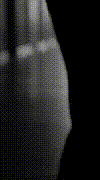
Hirtz Compass (1915)
The Hirtz compass was used to accurately determine where bullets were located in the body so that they could then be removed with precision.

Hysterotome/Metrotome (1860s-90s)
This hysterotome or metrotome was used to amputate the cervix during a hysterectomy.

Lithotome (1740s-1830s)
This lithotome was used to cut the bladder in order to remove stones. The shaft contained a hidden blade that was inserted into the bladder and then released using a spring handle.

Mouth Gag (1880s-1910s)
This wooden, screw-shaped mouth gag would be inserted into an anesthetized patient's mouth to keep the airway open.

Scarificator (1910s-20s)
Scarificators were used in bloodletting. The spring-loaded blades in this device would cut into the skin, and a special rounded glass cup could be applied over the wound. When warmed, it would help draw the blood out at a faster rate.

Skull Saw (1830s-60s)
This hand-cranked saw's blades were used to cut through sections of the skull, allowing for access by other instruments.

Tobacco Smoke Enema (1750s-1810s)
The tobacco enema was used to infuse tobacco smoke into a patient's rectum for various medical purposes, primarily the resuscitation of drowning victims. A rectal tube inserted into the anus was connected to a fumigator and bellows that forced the smoke towards the rectum. The warmth of the smoke was thought to promote respiration, but doubts about the credibility of tobacco enemas led to the popular phrase "blow smoke up one's ass."

Tonsil Guillotine (1860s)
This method of removing tonsils worked much like a traditional guillotine, slicing off the infected tonsils. This "double guillotine" design meant that both tonsils could be removed at the same time. Tonsil guillotines were replaced by forceps and scalpels in the early 20th century due to the high rate of hemorrhaging and the imprecise nature of the device, which often left tonsil remnants in the mouth.

Trephine (1800s)
This trephine was a hand-powered drill with a cylindrical blade that was used to bore into the skull. The spike in the center was used to start the procedure and to hold the blade in place while cutting.

Vaginal Speculum (1600s)
Specula have been used for thousands of years to allow doctors better vision and access to the vaginal area (or other body cavities) by expanding after insertion. This 17th century European example, which appears to use a cranking motion to expand, is more ornate and intimidating than most.





